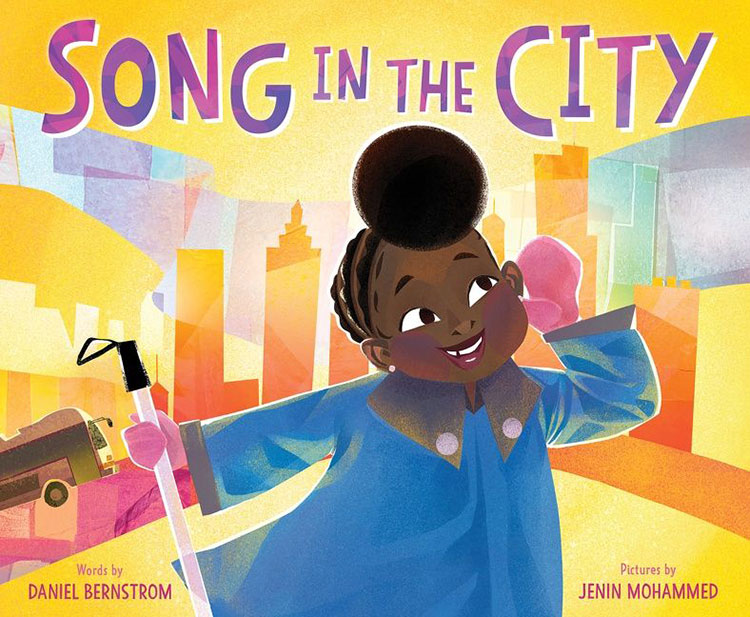Ever since that first childhood moment when I clapped two pot lids together and discovered the sounds that rang out, I’ve been fascinated by what sound can do to spark imagination and share information. I don’t use cookware as cymbals these days but am more quietly appreciative of how meaningful and beautiful the sounds around us can be.
Sound is an important connection with the world for visually impaired author Daniel Bernstrom. He writes joyful, rhythmic picture books for children, often featuring Black/Brown characters having everyday adventures. The kind of books you want to hear, again and again!

Daniel is a poet and the author of six picture books, including One Day in the Eucalyptus, Eucalyptus Tree (illustrated by Brendan Wenzel), Big Papa and the Time Machine (illustrated by Shane Evans), and A Bear, a Bee, and a Honey Tree (illustrated by Brandon James Scott). He’s also a full-time instructor (Children’s Literature, College Writing, and developmental English) at Minnesota West Community and Technical College.
When I met Daniel and he told me about newest book, Song in the City (illustrated by Jenin Mohammed), it sounded like a perfect title to share as we end our Tune In! summer of experiencing and celebrating the many forms of music in our lives.
September 26, 2022
Song in the City by Daniel Bernstrom

I'm a visually impaired writer. What does that mean? It means that I have trouble seeing things. Ever since I was young, I struggled to see. I could read and write, but things (the chalkboard, faces, picture books, street signs) grew fuzzier year after year. So, I grew to appreciate sounds. That is why I write lyrical books, stress creative rhythms, and love listening to books with beautifully chosen words. Because when I listen to those kinds of books, I see a song.
I wrote Song in the City because I wanted to share some of my joy as a visually impaired person. You see, there is a grand symphony playing all around us. The problem is, we can’t hear it. How do we hear it? Easy. Stop and listen.
Blindness, like any ability, is a spectrum, just as sound and light are spectrums. Some blind see a lot, and some see nothing at all. But blindness is an ability that allows the blind to appreciate other senses more because the sense of sight is limited. Humans are made to appreciate beauty, but beauty isn't only in what we see. There is an immense amount of beauty in what we hear. We can practice hearing. When we do, it will change our lives.
That was the message I shared in my book. It is loosely based on the structure of the symphony. What is a symphony?
A symphony is a musical story told in four parts. Each part of the story is called a movement. In Song in the City, A blind/visually impaired little girl and her grandmother go out into the city. They move from the street to the bus, to the church, and finally into one another’s arms. The text is musical, and each part of the story has a different sound pallet and rhythm pattern.

In a typical symphony, it’s the orchestra that plays the story. You don’t go to the symphony to listen to the instruments. No, you go to listen to the instruments singing a great story. That is why filmmakers such as Walt Disney and George Lucas wanted classical-styled music in their movies. They wanted to illustrate with pictures the story they saw in the music!
All stories are meant to be heard, so how does the orchestra tell its story? The orchestra is made up of stringed instruments (violins, violas, and cellos), brass (trumpets, trombones, and tubas), woodwinds (clarinets, saxophones, and flutes), and percussion (drums, tympani, and xylophone). These four “families” of instruments are led by a conductor who waves a beautiful white wand. Imagine the conductor’s wand is a little tongue, and the whole orchestra with all its instruments is the voice. The little white wand in the conductor’s moving hand is what tells and shapes the story written in the music. In my book, the conductor of my symphony is blind Emmalene. With her white cane in hand, she's the one who shapes the music of the city to tell a story song.
The story of Song in the City reminds us that when we take time to listen (to really listen) to our world and one another, our universe will expand outward while at the same time overflowing our hearts with wonder. The key is to listen. Invite kids to do a listening activity of their own and listen for symphonies in expected and unexpected places.

Listening activity
- Have kids write the numbers 1, 2, 3, and 4 down the side of the paper, leaving lots of room between numbers.
- Give kids something to listen to. Play Peter and the Wolf, go to concert, or take a field trip outside to a playground, a forest, a nature reserve, a city, or an orchestra hall.
- When you’ve reached your destination, ask kids to listen carefully to the sounds around them. Have them close their eyes and focus on listening for and remembering four distinct and unique sounds.
- After a period of listening (or when the concert ends), ask kids to complete their numbered lists by writing or drawing pictures of the four things they heard.
- Ask kids to share what’s on their lists and talk together about what they heard. Was it hard to hear distinct sounds? Did they hear any sounds that they couldn’t identify?
- Encourage them to take the sounds they heard and use them to tell a story! Or use the details they shared to write a poem to celebrate the sounds they heard.



